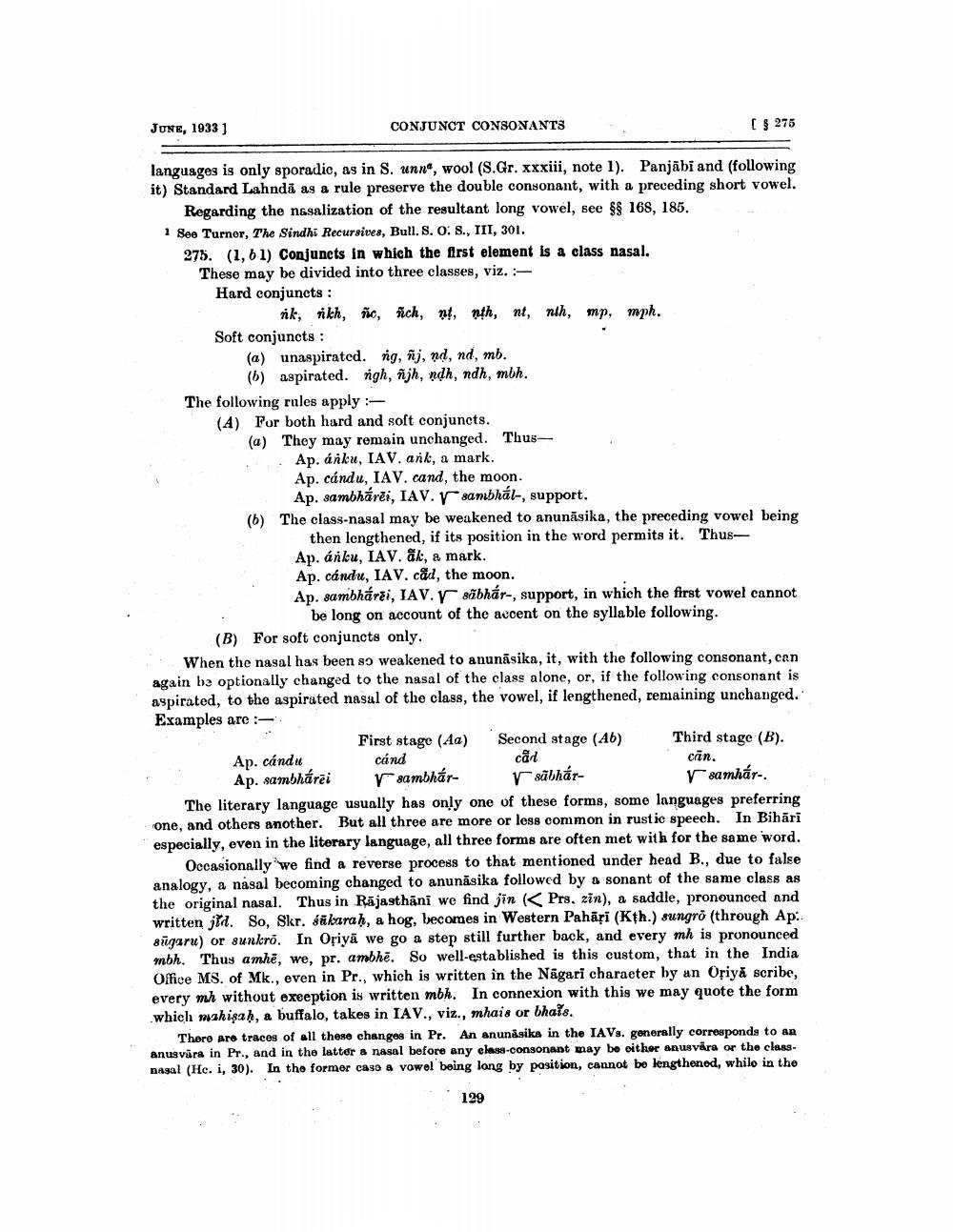________________
JUNE, 1933)
CONJUNCT CONSONANTS
[ $ 275
languages is only sporadic, as in S. unn, wool (S. Gr. xxxiii, note 1). Panjābi and (following it) Standard Lahndā as a rule preserve the double consonant, with a preceding short vowel.
Regarding the nasalization of the resultant long vowel, see $$ 168, 185. 1 Ses Turnor, The Sindhi Recursives, Bull. s. O: S., III, 301. 275. (1,61) Conjuncts in which the first element is a class nasal. These may be divided into three classes, viz. - Hard conjuncts :
rik, sikh, ñc, ñch, n, nth, nt, nih, mp, mph. Soft conjuncts :
(a) unaspirated.ng, ñj, nd, nd, mb.
(b) aspirated. ngh, njh, ndh, ndh, mbh. The following rules apply : (A) For both hard and soft conjuncts.
(a) They may remain unchanged. Thus: Ap. ánku, IAV. ank, a mark.
Ap. cándu, IAV. cand, the moon.
Ap. sambhārēi, IAV. r sambhál-, support. (6) The class-nasal may be weakened to anunāsika, the preceding vowel being
then lengthened, if its position in the word permits it. ThusAp, ánku, IAV. ák, a mark. Ap. cándu, IAV. cåd, the moon. Ap. sambhárei, JAV. r abhár-, support, in which the first vowel cannot
be long on account of the accent on the syllable following. (B) For soft conjuncts only. When the nasal has been so weakened to anunāsika, it, with the following consonant, can again be optionally changed to the nasal of the class alone, or, if the following consonant is aspirated, to the aspirated nasal of the class, the vowel, if lengthened, remaining unchanged.' Examples are
First stage (Aa) Second stage (Ab) Third stage (B). Ap. cándu
can. Ap. sambhárēir sambhár- r sābhár
r samhárThe literary language usually has only one of these forms, some languages preferring one, and others another. But all three are more or less common in rustic speech. In Bihāri especially, even in the literary language, all three forms are often met with for the same word.
Occasionally we find a reverse process to that mentioned under head B., due to false analogy, a nasal becoming changed to anunāsika followed by a sonant of the same class as the original nasal. Thus in Rājasthani we find jin K Prs, zin), a saddle, pronounced and written jid. So, Skr. sākaraḥ, a hog, becomes in Western Pahāri (Kth.) sungro (through Ap.. sügaru) or sunkero. In Oriyā we go a step still further back, and every mh is pronounced mbh. Thuy amhe, we, pr. ambhē. So well-established is this custom, that in the India Office MS. of Mk., even in Pr., which is written in the Nagari character by an Oriya scribe, every mh without exception is written mbh. In connexion with this we may quote the form which mahipah, a buffalo, takes in IAV., viz., mhais or bhai's.
There are traces of all these changes in Pr. An anunåsika in the IAV9. generally corresponds to an anusvārs in Pr., and in the latter & nasal before any elass-consonant may be either snusvåra or the class. nasal (Hc. i, 30). In the former caso a vowel being long by position, cannot be lengthonod, while in the
cánd
cad
129




